Part 1: Introduction

Once again, we begin a Killzone LP not with any gameplay but with the opening cinematic video. The music is top notch, with Joris de Man once again in top form. However, the video itself is something of a wet fart. Not a good way to start the LP, I know, but it's true. Compared to the opening cutscenes for the first three games this one feels decidedly phoned in. Don't take my word for it, watch it for yourself.

At this point, Killzone 1's opening cinematic is pretty classic. It looked great on the PS2 and still holds up as a decent cinematic largely in part due to Brian Cox's brilliant VA. I had a lot of good things to say about it in the first LP. Liberation's biggest sin is that its opening cinematic is just kinda of generic and has a total absence of Brian Cox. The less we dwell on THAT sorry fact, the better. Killzone 2 gave us pretty much the best goddamned opening cinematic on the entire goddamned PlayStation 3. I mean, damn. Seriously. What a well-cut cinematic. Again, I had a lot of good things to say about it. For Killzone 3, it's a tough act to follow and it sadly does not live up to expectations. Maybe Guerrilla Games realized they couldn't just keep giving us more of the same. Instead, they change it up a little. Make it a flashback. Throw in some new characters and text narration to—
Wait.
Fucking text narration?
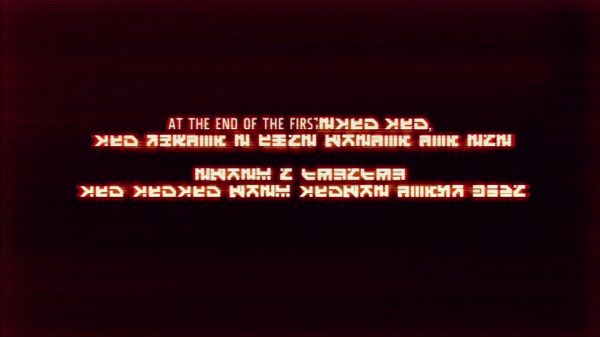
For shame!
Okay, so full disclosure: Killzone 3, despite being Shakespeare, is more or less a tech demo like all the Killzones before it. Killzone 3's big claim to tech demo fame is that it was one of the first titles to really take advantage of 3D gaming and the PlayStation Move controls. Or something. I never bothered. Anyways, I bring this up because as a result of that this game got bundled in with a lot of Sony 3DTV/PS3 sales packages. Suddenly a whole new audience was introduced to the Killzone universe with Killzone 3 as someone's uncle bought it during a Boxing Day sale at Future Shop. Considering this is the third game in the series, it's important to catch them up on the details. Only I feel the text narration was a misstep. This series has always been about having a rich, deep, and complex lore leading up the each game's events. The opening cinematics in earlier games existed to have Visari info dump all this lore into players' laps. I mean, I dunno, maybe all the funding for Malcom McDowell and Ray Winstone limited how many lines Brian Cox was willing to record. Regardless, here we are. With a text narration.
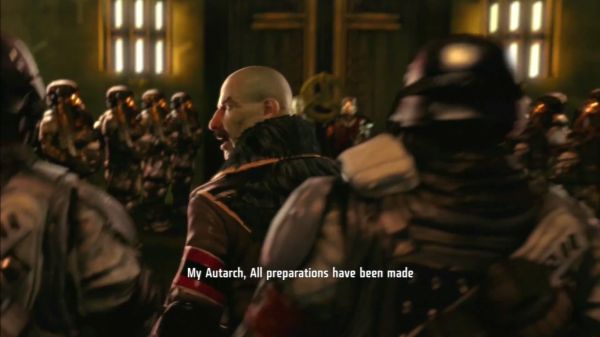
With the info dump out of the way, the game dumps us literally into Visari's shoes. We get to see the world through this egomanical dictator, if only for a moment. In these brief moments, we are introduced to pretty much his entire inner circle all in rapid succession. (Those that don't appear are already dead at the time of this flashback (i.e., Lente, Metrac, and Cobar)). This guy up front is Admiral Orlock. We're sort of familiar with his handiwork from the previous game. No Helghast civilians appear in Pyrrhus City during the game's events because Orlock had evacuated them all. It's his ships that fly in at the very end basically dooming all of the remaining ISA forces:
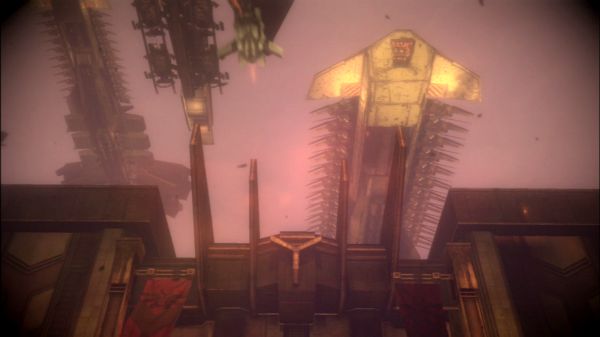
The game doesn't stop though. Immediately afterwards, we meet a familiar face and a new character.
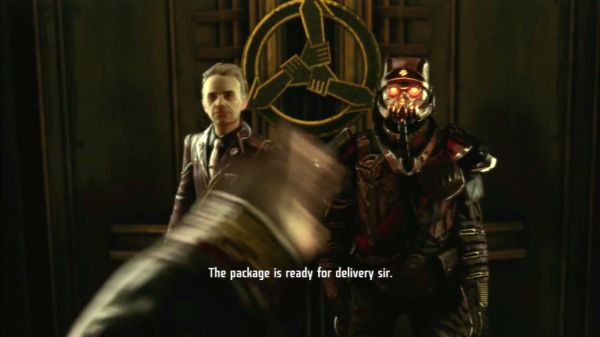
That's ol'Radec to the right

The other man is
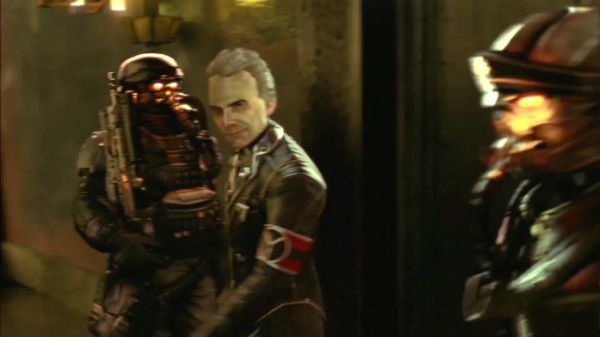
He's already throwing smug glances our way.
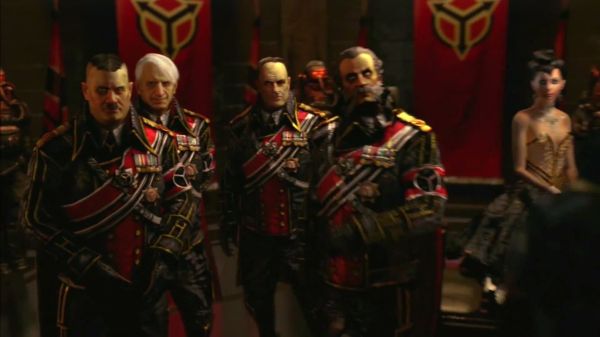
Then we meet the Helghast Senate. More about these creeps and Nazi cosplayers later.
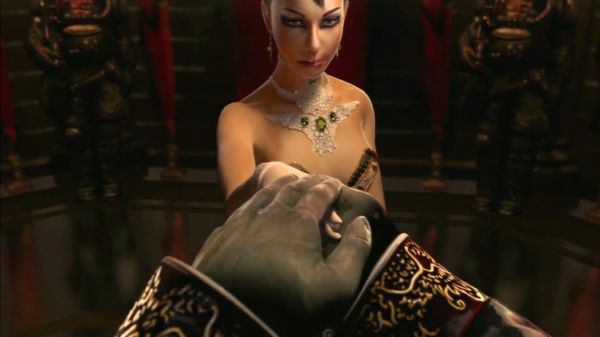
Then we meet Visari's daughter, Hera.
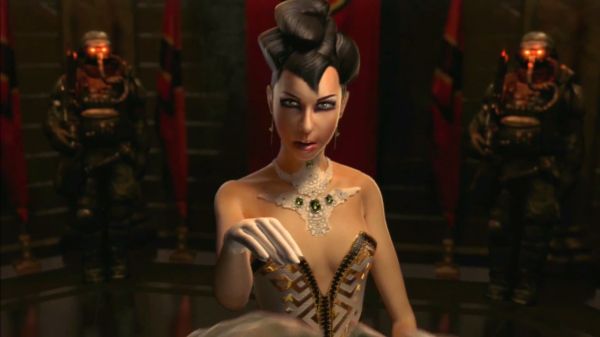
Clearly there is some repulsion between her and her father. This doesn't really go anywhere for now. Hera's significance in Killzone 3 begins and ends in this cutscene.
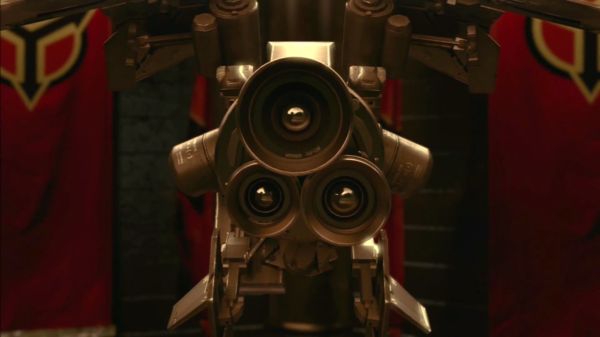
Ah, and then Visari's favourite character shows up: Helghast Media. Propaganda. It's at this point where he starts to spin his lies once again.
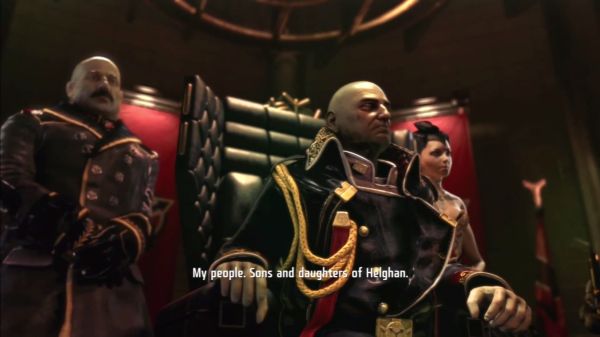
"Speech! Speech! Speech!"
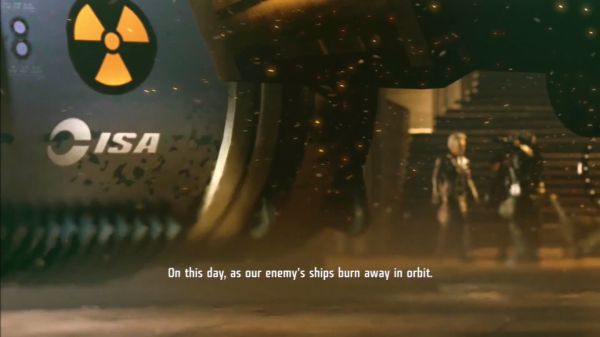
Tragically, the speech here lacks the charm and charisma that Brian Cox brought to the role in the earlier two games. I mean, it's fine. It's serviceable. It's just not brilliant and perhaps that's why it's so disappointing. This flashback only serves to remind the player that Visari is dead. There will be no further opportunities for Brian Cox to chew the scenery outside of flashbacks. Perhaps that's why it feels so hollow? Note who gets to stand with Visari in the propaganda video, though: Hera and Orlock.
Anyways, we're introduced to another new element: the Red Dust nuke. Whether you notice it or not, this was the prime focus of Killzone: Liberation and Killzone 2. To quickly recap, the Red Dust nuke was developed by the ISA to be a high-explosive blast, low-radiation yield bomb. The ISA planned to drop it on their own cities to halt the Helghast invasion of Vekta. The reasoning being that because the radiation would dissipate relatively quickly they could just rebuild their cities on the bones of their invaders. The idea was shot down but not before spies stole the nuke and put it in Visari's hands. Ironically enough, Visari dropped it on his own city to halt the Vektan invasion of Helghan.
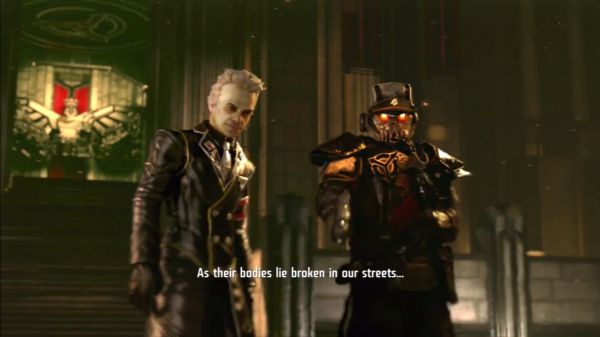
So while Hera and Orlock get to be part of the public face of the Helghast leadership, its people like Radec and Stahl who do the dirty work for Visari.
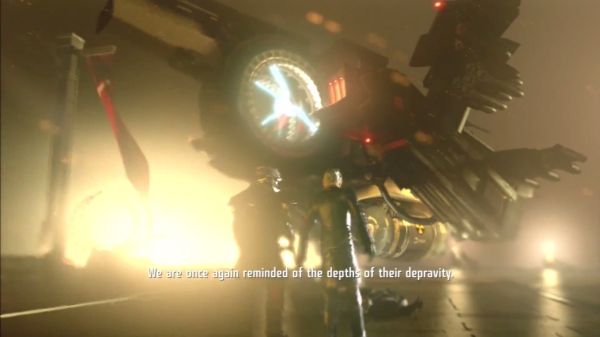
Biggest thing of note here is that ship. It's powered by petrusite. We're going to see more and more weapons using this unstable ore.
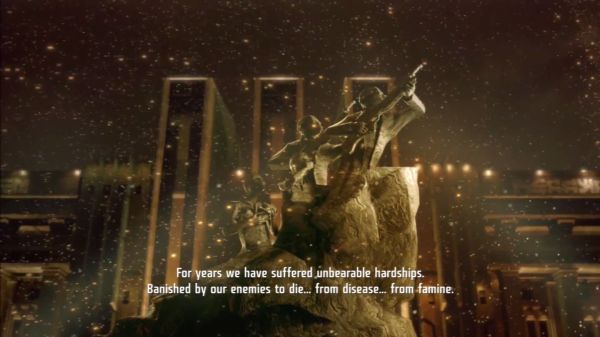
Moving on, it's this part of the video where Guerrilla starts to get clever again. Well, I mean, the message is pretty on the nose, but the imagery looks real nice. I feel like Guerrilla Games got tired of Killzone fans missing the point of the game series and whinging about how the Helghast are actually the good guys and the ISA are oppressive space fascists trying to suppress a brilliant and strong culture. Over the course of three games, I'd like to think it's become apparent that, actually, both of them are bad. We're caught in the middle of a war between two shitty governments. However, people love the Helghast. Again, not just as villains, but believe them to be the heroes of this series.

Look at that! So heroic. Those brave Helghast citizens working together with its brave soldiers! It's a monument to their hard word and perseverance as a people.
It's blatant propaganda. We've seen the slums of Helghan in Killzone 2. Your average Helghan citizen lives a shitty, shitty life. Life sucked before Visari and it continued to suck with him—only now there's a military system in place that will silence anyone who opposes them—oh, and they also dragged the whole planet into a war.
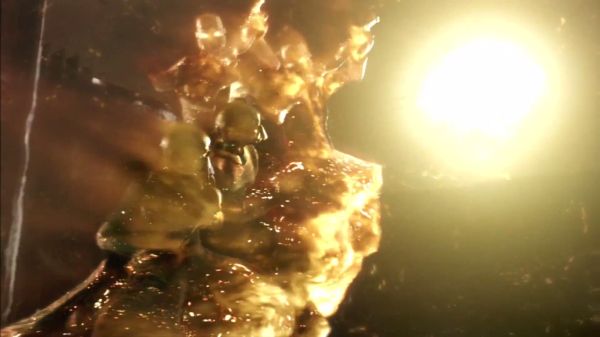
It's at this point the nuke goes off. You know, the nuke that Visari stole from the ISA. He dropped it on his own city. As the blast wave rolls over the landscape, it strips away the lies built by Visari and the Helghast. I mean, look at it! If there was ever any doubt that the Helghast might secretly be the good guys of the series then let that be laid to rest. The soldiers hurt the common people.
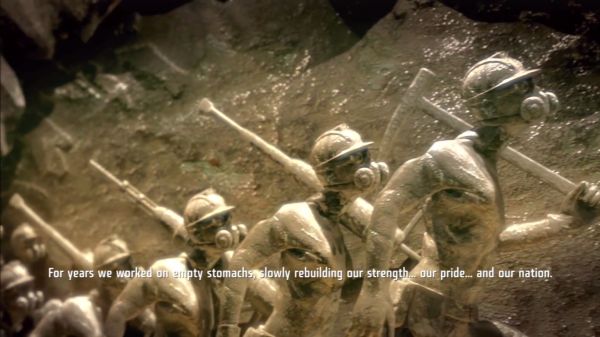
Once again, a monument to Helghan's workers.
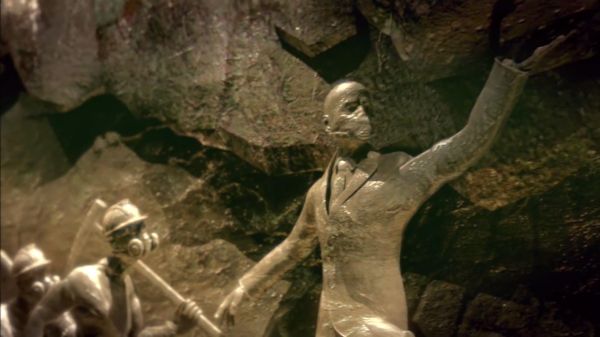
Once again, they're being led by someone, presumably a Helghast officer.
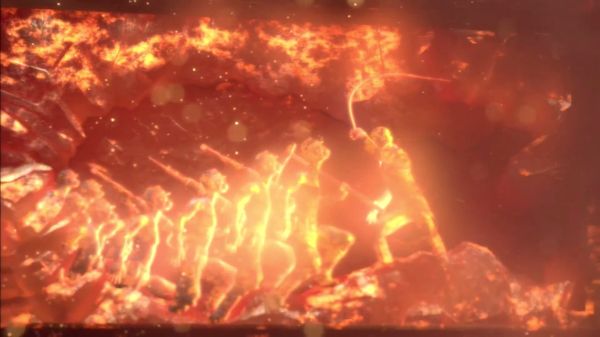
Aaaand once again, the blastwave hits and its twisted into a more accurate hellscape. The Helghast leadership is bad, they hurt the common people.
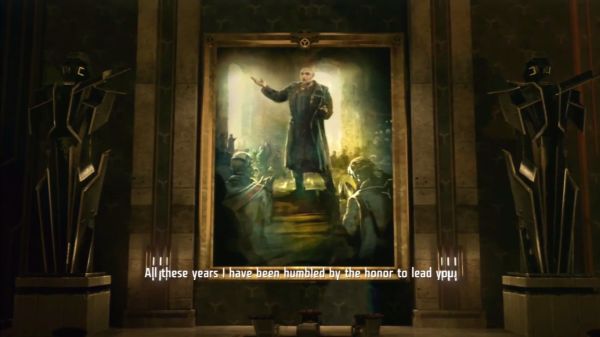
Looking for someone to blame for this? Well, you can place the blame on the shoulders of Visari. I love what happens to his portrait here. Very on the nose, but I like the transition.
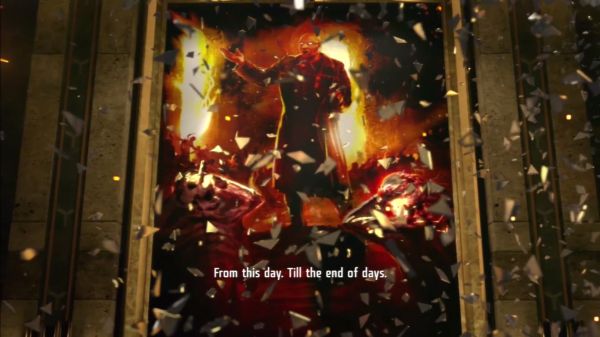
Helghan burns in the background as Visari stands tall, eyes glowing, like some sort of specter or demon from hell. The people in the foreground have turned into screaming skeletons.
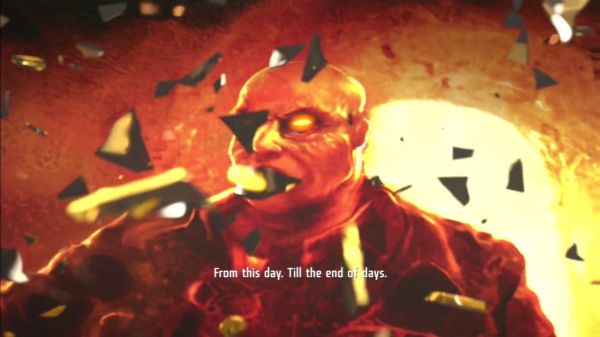
Visari=bad.

And he knows it.

Sally note: thanks to crow for doing the Character write-up for this post.
This sequence is very economical in its visual storytelling and world building, and needs to be unpacked a little bit before we move on, as it introduces us in rapid succession to the cast of characters who will be spending the remainder of the Killzone franchise (up to Shadow Fall, at least) fighting over the scraps of Visari’s legacy. They are, in order of their introduction:
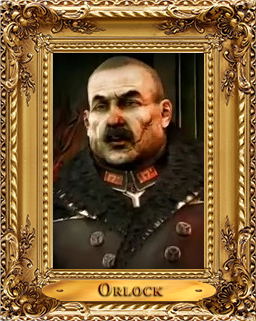
Admiral Orlock. Orlock, ostensibly, will be our Visari stand-in for Killzone 3. As of the end of Killzone 2, Orlock is the highest ranking member of the Helghan military still alive after Visari’s military cabinet was essentially bled dry over the course of Killzones 1, Liberation, Mercenary, and 2.
Orlock represents the military faction in the internal battle over Visari’s crown. He believes in the old pre-Visari ways of succession, that Helghan should go, in the words of Alexander the Great, “to the strongest.” …Unfortunately, Metrac and Radec are both dead, and I wouldn’t trust Lente to run a 7/11 let alone a planet if he were still alive, so Orlock’s all we got.
That said, despite him ostensibly being the most powerful person on Helghan in the wake of Visari’s death, he has few real allies, and has landed in control over a largely soldier-centric army that quietly resents now having to answer to a naval branch that has been so far spectacularly ineffective in combat situations. Orlock may be top dog at the outset of Killzone 3, but he is going to have to fight like mad to say on top.

Jorhan Stahl. We’ve been pre-figuring his introduction since all the way back to the original Killzone, and now he’s finally here in the flesh. Jorhan Stahl, the CEO of the Stahl Arms Corporation, represents the private sector in this tug of war for Visari’s vacant crown. As the head of Helghan’s largest corporation, the primary weapons supplier to the Helghast military, and owner of a vast private army onto itself, Jorhan Stahl is functionally the most powerful man on Helghan, while Orlock is only nominally.
Stahl holds the entire Helghan economy in his hands, so everyone else at the table needs to play nice with him lest he take his ball and go home and hang the empire out to dry. That means indulging his otherwise irascible dickishness and grasps for greater power.
Stahl believes that as a successful businessman he’s better suited to ruling Helghan than any of these incompetent military leaders or politicians. The thing of it is, Stahl inherited his already hugely successful company from his father, Khage Stahl, who founded Stahl Arms decades ago. Stahl is a poster child for wealthy entitlement and illusory superiority. Regardless, he is of the opinion that Helghan should go back to being under corporate rule, like it was at the time of its founding. He’s opposed in this effort of course by both Orlock and the Senate, and while Orlock is the immovable object to Stahl’s unstoppable force, Stahl does have his share of allies in the Senate that support his views. Although, the semi-canon Killzone 3 novelization reveals that they’re not exactly allies by choice, as Stahl has all sorts of career-ending and life-ruining dirt on several senators, whose support is paid for with his silence.
Given his massive entitlement complex, his corporate background, aspirations to power (despite political inexperience), and dubious emotional intelligence, it's a little hard not to view Stahl as some sort of "Life Imitates Art" facsimile of Donald Trump, at times. Now more than ever...
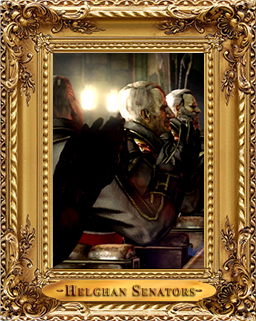
The Helghan Senate. The deliberative and lawmaking body of Helghan. Prior to Visari’s death, the senate was just rubber stamp giving a veneer of legality to their Autarch’s agenda. In the wake of Visari’s death, the senate has suddenly become the most important and actually powerful body in the grand tug of war for the reigns of Helghan. Only the senate can name an official successor to Visari, something they have been reluctant to do, and with good reason.
The senate sees the chaos of Visari’s death as an opportunity to expand their own power and would like to name a successor on their terms, and an Autarch sympathetic to or even in debt to the Senate would be their prefect candidate. …Good luck with that one guys. Trying to wrangle Orlock and Stahl to heel is like stepping in the middle of a fight between two grizzlies to ask one of them for their autograph.
While they have comparatively minimal dialog compared to Orlock and Stahl, their various reactions to events across the game should give you an inkling as to whom each individual senator favours and who’s on their shitlists.
The Senate as a group was modeled after various dictators or extremist ideological philosophers. Just from a cursory glance at them one can recognize elements cropped from the likes of Adolf Hitler, Joseph Stalin, Franz Joseph I of Austria, Benito Mussolini, Karl Marx, Rudolf Hess, and others.
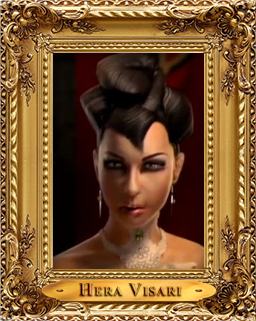
Hera Visari. Visari’s daughter makes a blink and you’ll miss it cameo in the opening to Killzone 3, but her importance to the franchise is only in its infancy here. Her cameo here is meant to be Marie Antoinette “let them eat cake” moment, contrasting the private opulence of Visari’s household with the ruinous poverty seen across Helghan over the course of Killzones 2 and 3. Yet, Guerrilla was so intrigued by her character that they brought her back for Killzone: Shadow Fall in an expanded role.
Without spoiling who ultimately “wins” control over Helghan in Killzone 3, control over the Helghast eventually falls into Hera’s hands some 30 years down the road from where we are now in the franchise. Chancellor Hera Visari plays a very prominent role in Shadow Fall, but that’s all in the future from our perspective. For now, this will be the last we see of her in Killzone 3, as she’s immediately shepherded off of Helghan before the destruction of Phyrrus City to spend the remainder of the war with the ISA on the Helgast-sympathetic colony of Gyre.

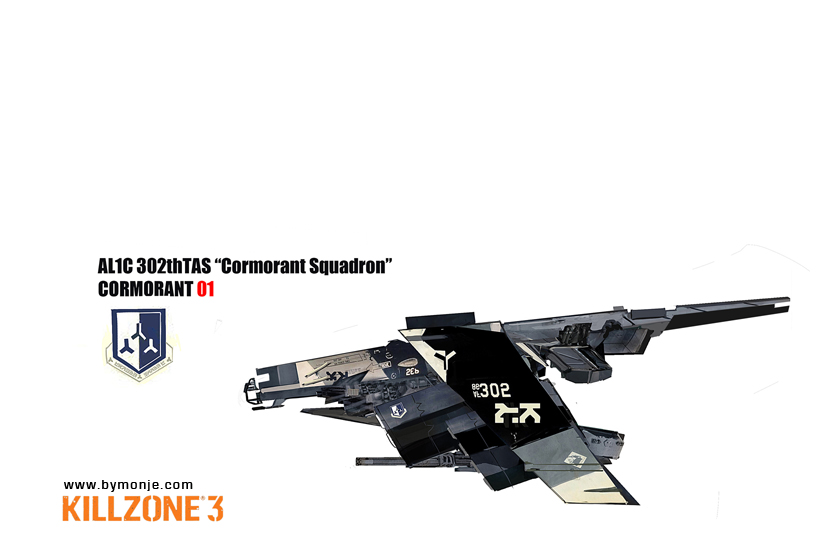
Helghast Strike Fighter
Deployed late in the Second Extrasolar War due to its Arc powered technology being such a recent development. It's large size is meant for it to function in space as well as in a planet's atmosphere. The first use of the Strike Fighter was to drop the Red Dust nuke of Pyrrhus, though it would continue to see use afterwards. The Arc tech ring gives this heavily armoured craft nigh-unlimited hovering capabilities, making it an excellent VTOL craft. They are twice the size of the standard Helghast Overlord Dropship, allowing for a co-pilot and pilot as well as several passengers behind. Thrusters all over the ship allow to maneuver easily in space. Controls have been simplified so that minimal training is required to pilot it.

Trailers for Killzone 3. They're pretty good! Worth checking out for all the cool action.
Heck, nine-gear crow even made a pretty good trailer for this damnéd LP:
Lastly, some concept art. Orlock and Stahl went through a few revisions before Guerrilla settled on their final design, but I'll get to some of prototypes later—once we get to know them a little better. In the mean time, here are a pair of portraits of their final designs:
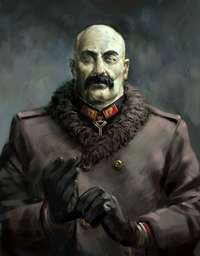
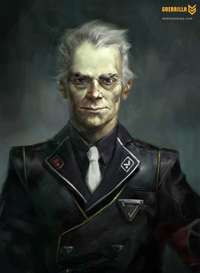
I also appreciate the effort and detail put into Hera, a character who really isn't a part of this game. The detail on her hair and gown is incredible:

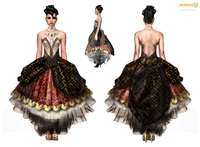
Some earlier concept art of Hera's gown:
